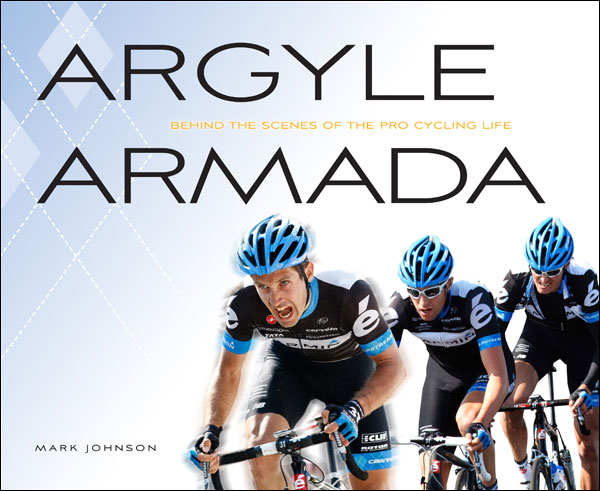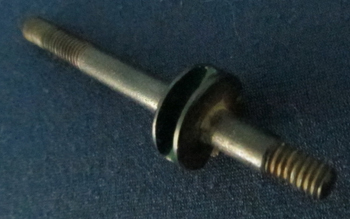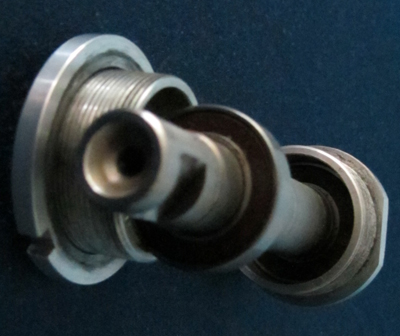Vol. 2, Issue 40 – July / August 2012
Posted: Friday 13th July 2012
Until recently I feel that I have managed to keep abreast of mechanical advances in bikes but in the last few years things seem to have leapt forward so far and so fast I am no longer confident that this is the case. I can understand power cranks and hubs, electric gear changes and similar advances, but:
Headsets have become integral, which is straightforward, but now that they use different diameters top and bottom that is another difference to absorb. I hear endless stories about the problems people have in getting the right combinations of bearing sets, etc. when building up bikes.
Bottom brackets are another example of this trend, with interior and exterior brackets, some requiring ‘liners’ to correct diameter differences. A lot of this seems rife, even amongst the new breed of fixed-wheel machines that one would imagine to be simple in concept.
I do read the LFGSS forum regularly where such queries are often discussed and would like to think I could understand their problems but, more and more, I find myself waiting to hear the answers – usually becoming more baffled as a result. On the forum there are one or two cycle mechanics so there’s lot of technical knowledge there. I find it difficult to learn this way unless I have the item in front of me to work on, or to see someone working on it. An age thing I suspect.
Some time ago I wrote in Lightweight News about the intriguing ways devised by “barrow boys” who have the problem of fitting two brakes to a trike if it has a freewheel and/or gears rather than a fixed-wheel. The law in the UK being that a bicycle/tricycle must be fitted with two brakes. However, if it has a fixed-wheel that counts as one method of braking, hence many fixed bikes with a single brake. I recently saw a Longstaff racing trike parked up outside the local Tesco supermarket (as you do!) and noticed the simplest, neatest answer to the problem I have ever seen. It consisted of a pair of braze-on bosses on both the front and the rear of the fork blade. Each pair were fitted with V-brakes, a modern version of the cantilever brake.
This seems to be the most mechanically sound system I have seen so far. For some reason the bosses were not exactly opposite each other, being a few millimetres off-line: maybe this is to reduce the amount of heat applied to the fork in one area although the distance was so small it is hard to imagine it was enough to make a difference. Perhaps it was to allow a front and rear pair of callipers to be used. I guess the way forward is with disc brakes, maybe even one each side – that would certainly stop it but would the forks be able to take the ‘reverse thrust’ combined with the leverage created with braking at the fork end!
On the way home I stopped at a light-controlled crossing and noticed that the young woman standing next to me had a decent-looking bike with genuine old roller-lever brakes. I remarked how nice it was and she said that had been her grandmother’s when she was a post-woman in Lincoln and that when she retired she was allowed to keep it. Also that her father had spruced it up for her. I then noticed the large braze-ons which would have been for the carrier (which was not fitted). Nowadays I guess the post office would have given her an invoice for use of the bike over all those years (Sorry Steve!) as well as taking it back.
In the 1970’s I lightened many components by drilling and milling, as was the fashion of the day, now referred to as “drillium,” though I don’t recall the term being used at the time. When I started considering building an early ’50s TT bike I wanted to lighten the componentry. Rather than just drilling holes everywhere, I decided to make alloy parts to replace the steel ones and the use of alloy fasteners (Toronto Cycles has an extensive inventory of aluminum and titanium fasteners). As a long-time visitor to your website, I thought this re-work might be of interest.
I started with a rather “ratty” set of GB “Coureur” brakes. The first order of business was to dissemble, remove casting flash, and polish and straighten the centre mounting bolts. I trimmed the ends of the springs and all steel parts were “gun blued.” The post for the quick release cam was shortened, eliminating the locknut, and now is “loc-tited” in. The only milling was done on the centre bolt bung. The front is deeper than the rear, as the front calipers tend to rise during braking; the rear is opposite.
Book review: Argyle Armada: The All-Access Pass to Pro Cycling
If, like me, you watch the Tour de France on television, you get some idea of the logistics, team plans and organisation needed to run a team so large. To get a unique insight into what it takes, a new book, Argyle Armada: Behind the Scenes of the Pro Cycling Life, delivers an unprecedented look inside the sport and lifestyle of professional cycling. Embedded with Team Garmin-Cervélo for its 2011 season, writer-photographer Mark Johnson brilliantly chronicles the team’s most intimate personal dramas and public celebrations. From winter training camp on the cobbled lanes of medieval Girona, Spain, to hard-earned stage victories in July’s Tour de France, to flesh-shredding crashes at the Vuelta a España in September, Argyle Armada brings the life and work of a pro cycling team into focus through incisive writing and spectacular colour photographs. Download a preview chapter of the book and find book tour dates at www.argylearmada.com. The book is now available in the U.K. at good bookshops or direct from www.cordee.co.uk.
I found it fascinating right from the first chapter which starts with the team’s winter training and then one is taken to a huge industrial-style storage building, so large that the two team transporters are lost in it, gradually, all the component parts of the team, frames, wheels, even down to team suitcases are assembled ready for the start of the 2011 season. It was one of those books I had to keep on reading to find out what happened next.
The titled puzzled me for a while until I realised that the team strip has contained an Argyle pattern for several seasons. Although it is not so prominent now, it is still there on the jerseys.
More than a book about racing, Argyle Armada is a portrait of life as a member of a pro cycling team during a time of painful transition for the sport. Johnson unveils the dramatic forces that Garmin-Cervélo must navigate as team founder Jonathan Vaughters tries to push forward his vision of a reformed sport. Along the way, countless difficult decisions must be made to keep the team competitive in the chase for ProTour points, money, respect, and fame.
With all-access insight and spectacular colour images, Argyle Armada is a backstage pass to the world of professional cycling.

Argyle Armada: Behind the Scenes of the Pro Cycling Life Text and photographs by Mark Johnson, foreword by Jonathan Vaughters
Hardcover with jacket. Full-colour photographs throughout.
280mm x 229 mm, 224 pp., £29.95, 978-1-934030-81-3
Mark Johnson has covered cycling as a writer and photographer for national and international publications since the 1980s. His work has been published in cycling magazines including VeloNews in the United States, Cycling Weekly in the UK, Velo in France, and Ride Cycling Review in Australia as well as general-interest publications including the Wall Street Journal and the San Diego Union-Tribune. A Category II road cyclist, Mark has also bicycled across the United States twice and completed an Ironman® triathlon. He has a PhD in English literature from Boston University and has worked as a freelance writer and photographer for the Slipstream Sports cycling team since 2007. His other passion is surfing, which he does frequently from his home in Del Mar, California. Find more of Mark’s photographs and writing at www.ironstring.com.
Argyle Armada retails in the U.K. for £29.95. Available at good bookshops or direct from www.cordee.co.uk.
John Purser from Sudbury in Suffolk: (at my request – Ed.)
John Nicholson, the multiple world sprint champion, used a ‘fixed’ bike on the road with a centre-pull brake at the front complete with a straddle wire and then looped a toe strap over the bars to actuate the brake which saved fitting a brake lever.
It seems strange to have a brake hole in the forks but, yes, this was his leg-loosener bike rather than his main racing frame. He did have two bikes: in fact that was in the pro’s contracts with sponsors or promoters, that they brought enough equipment to cope with crashes. In those days, there were few of the team vans and support crews seen today. When all the pro sprinters came to UK for the three Easter track meetings, I acted as gopher, chauffeur and mechanic.
I had the same role at Marseilles. Gordon Johnson was on his own, I was his ‘helper’ as the Australian Cycling Federation was not there! My main job was to get a Raleigh hat on his head at every TV/photo opportunity.
Frames were never the most important thing. A drilled crown would rarely break if drilled. The main focus was on wheels, strong and light. Light and strong. John was later sponsored by Shimano who made a special 10mm pitch chain (not 1/2″), chain wheel and sprockets for him, but they never caught on – weight saving in transmission was the goal.
Happy memories. We should all be famous for 15 seconds !
I am one of those people who learn the hard way and having owned a Les Ephgrave bike in the sixties which I sold I did the same thing again in the nineties! So I am writing to in the hope that if you ever hear of a sixties No1 Ephgrave frame or bike for sale in any condition please pass on my details. Size between 22″ – 23½”. Contact peter.bryant(at)icefilm.com
John Crump – I am looking for a 50’s Billy Gameson frame 21″ If you hear of one PLEASE let me know. Best regards. John Crump (USA now, but originally from the Midlands)
Paul Harding – I want to purchase for restoration an early 1960s Mercian and would like to go for aluminium componentry and something a little brighter in terms of frame colour as most of my cycles are somewhat tame with Chater steel components or similar. Tatty would be good and model not too important as all Mercians seem to ride well. I am looking for a 22-23″ frame.
Peter Beaven:
1, Does anyone have any information on Tom Maysh? A friend has a frame in original paint that I would guess is a late thirties model.
2, Another friend has an R O Harrison Omnium 23.5″ 1951. With period underslung stem and a nice headset. The rest of the bike is rather newer. £450. Contact Peter Beaven. Photos available.
Posted: Friday 13th July 2012
This article appears in the following categories.
Upcoming Events
Whether you are looking for a gentle social meet up, or a 100-mile ride browse the community’s upcoming events and plan your next weekend outing.








